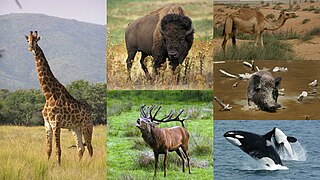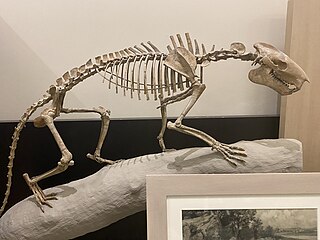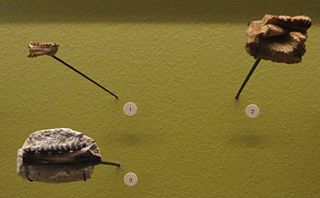
Artiodactyls are placental mammals belonging to the order Artiodactyla. Typically, they are ungulates which bear weight equally on two of their five toes. The other three toes are either present, absent, vestigial, or pointing posteriorly. By contrast, most perissodactyls bear weight on an odd number of the five toes. Another difference between the two orders is that many artiodactyls digest plant cellulose in one or more stomach chambers rather than in their intestine. Molecular biology, along with new fossil discoveries, has found that cetaceans fall within this taxonomic branch, being most closely related to hippopotamuses. Some modern taxonomists thus apply the name Cetartiodactyla to this group, while others opt to include cetaceans within the existing name of Artiodactyla. Some researchers use "even-toed ungulates" to exclude cetaceans and only include terrestrial artiodactyls, making the term paraphyletic in nature.

Entelodontidae is an extinct family of pig-like artiodactyls which inhabited the Northern Hemisphere from the late Eocene to the early Miocene epochs, about 38-19 million years ago. Their large heads, low snouts, narrow gait, and proposed omnivorous diet inspires comparisons to suids and tayassuids (peccaries), and historically they have been considered closely related to these families purely on a morphological basis. However, studies which combine morphological and molecular (genetic) data on artiodactyls instead suggest that entelodonts are cetancodontamorphs, more closely related to hippos and cetaceans through their resemblance to Pakicetus, than to basal pigs like Kubanochoerus and other ungulates.

Mesonychia is an extinct taxon of small- to large-sized carnivorous ungulates related to artiodactyls. Mesonychians first appeared in the early Paleocene, went into a sharp decline at the end of the Eocene, and died out entirely when the last genus, Mongolestes, became extinct in the early Oligocene. In Asia, the record of their history suggests they grew gradually larger and more predatory over time, then shifted to scavenging and bone-crushing lifestyles before the group became extinct.

Phenacodus is an extinct genus of mammals from the late Paleocene through middle Eocene, about 55 million years ago. It is one of the earliest and most primitive of the ungulates, typifying the family Phenacodontidae and the order Perissodactyla.

Pakicetus is an extinct genus of amphibious cetacean of the family Pakicetidae, which was endemic to Pakistan during the Ypresian period, roughly 50 million years ago. It was a wolf-like mammal, about 1 metre to 2 metres long, and lived in and around water where it ate fish and other animals. The vast majority of paleontologists regard it as the most basal whale, representing a transitional stage between land mammals and whales. It belongs to the even-toed ungulates with the closest living non-cetacean relative being the hippopotamus.

Palaeotherium is the type genus of the extinct perissodactyl family Palaeotheriidae, a Palaeogene-exclusive lineage within the superfamily Equoidea that diverged from the extant Equidae by the Palaeocene to early Eocene. The genus lived in Europe and possibly the Middle East and ranged from the middle Eocene to the early Oligocene. Fossils of Palaeotherium were first described in 1782 by the French naturalist Robert de Lamanon and then closely studied by another French naturalist Georges Cuvier since 1798. Cuvier erected the genus name in 1804 and recognized multiple species up to 1824 based on overall fossil sizes and limb bone morphologies, although several were eventually reclassified to other perissodactyl genera by other naturalists. It was the fourth fossil mammal genus to be described with official taxonomic authority and is recognized as an important milestone within the field of palaeontology due to contributing to the developing ideas of evolution, extinction, and succession and demonstrating the morphological diversity of different species within one genus.

Diacodexis is an extinct genus of small herbivorous mammals belonging to the family Diacodexeidae that lived in North America, Europe and Pakistan from 55.4 mya to 46.2 mya and existing for approximately 9.2 million years.

Ichthyolestes is an extinct genus of archaic cetacean that was endemic to Indo-Pakistan during the Lutetian stage. To date, this monotypic genus is only represented by Ichthyolestes pinfoldi.

Mesonychidae is an extinct family of small to large-sized omnivorous-carnivorous mammals. They were endemic to North America and Eurasia during the Early Paleocene to the Early Oligocene, and were the earliest group of large carnivorous mammals in Asia. Once considered a sister-taxon to artiodactyls, recent evidence now suggests no close connection to any living mammal. Mesonychid taxonomy has long been disputed and they have captured popular imagination as "wolves on hooves", animals that combine features of both ungulates and carnivores. Skulls and teeth have similar features to early whales, and the family was long thought to be the ancestors of cetaceans. Recent fossil discoveries have overturned this idea; the consensus is that whales are highly derived artiodactyls. Some researchers now consider the family a sister group either to whales or to artiodactyls, close relatives rather than direct ancestors. Other studies define Mesonychia as basal to all ungulates, occupying a position between Perissodactyla and Ferae. In this case, the resemblances to early whales would be due to convergent evolution among ungulate-like herbivores that developed adaptations related to hunting or eating meat.

Interatherium is an extinct genus of interatheriid notoungulate from the Early to Middle Miocene (Colhuehuapian-Mayoan). Fossils have been found in the Santa Cruz, Collón Curá and Sarmiento Formations in Argentina.
Duerotherium is an extinct genus of Palaeogene artiodactyls known only from the Iberian Peninsula during the Middle Eocene, which contains one species D. sudrei. It, like other members of the Anoplotheriidae, was endemic to western Europe. The anoplotheriine was described from a left fragment of a maxilla from the Mazaterón Formation of the Duero Basin in 2009. Its dentition is mostly typical of the Anoplotheriinae but differs by an elongated plus triangular 3rd upper premolar and very specific traits of the molars. It is thought to have been part of an endemic faunal assemblage that evolved within the Iberian Peninsula by the Middle Eocene, where climates were subtropical.

Agriochoerus is an extinct genus of scansorial herbivore of the tylopod family Agriochoeridae, endemic to North America. Agriochoerus and other agriochoerids possessed claws, which is rare within Artiodactyla, as well as likely being scansorial. Agriochoerus was first described in 1869.

Xiphodon is the type genus of the extinct Palaeogene artiodactyl family Xiphodontidae. It, like other xiphodonts, was endemic to western Europe and lived from the middle Eocene up to the earliest Oligocene. Fossils from Montmartre in Paris, France that belonged to X. gracilis were first described by the French naturalist Georges Cuvier in 1804. Although he assigned the species to Anoplotherium, he recognized that it differed from A. commune by its dentition and limb bones, later moving it to its own subgenus in 1822. Xiphodon was promoted to genus rank by other naturalists in later decades. It is today defined by the type species X. gracilis and two other species, X. castrensis and X. intermedium.

Cainotheriidae is an extinct family of artiodactyls known from the Late Eocene to Middle Miocene of Europe. They are mostly found preserved in karstic deposits.

Helohyidae were a group of artiodactyl mammals. They were most prominent in the mid-to-upper Eocene.

Achaenodon is an extinct artiodactyl mammal, possibly belonging to the family Helohyidae. It lived in the mid-late Eocene and its fossil remains have been found in North America.

Dichodon is an extinct genus of Palaeogene artiodactyls belonging to the family Xiphodontidae. It was endemic to western Europe and lived from the middle Eocene up to the earliest Oligocene. The genus was first erected by the British naturalist Richard Owen in 1848 based on dental remains from the fossil beds in Hordle, England. He noticed similar dentitions to contemporary artiodactyls like those of the Anoplotheriidae and Dichobunidae and references the name of the genus Dichobune. Eventually, it was found to be more closely related to Xiphodon and now includes 11 species, although one of them may be synonymous.
Megadolodus is an extinct genus of proterotheriid litopterns.

Periptychus is an extinct genus of mammal belonging to the family Periptychidae. It lived from the Early to Late Paleocene and its fossil remains have been found in North America.

Dacrytherium is an extinct genus of Palaeogene artiodactyls belonging to the family Anoplotheriidae. It occurred from the middle to late Eocene of western Europe and is the type genus of the subfamily Dacrytheriinae, the older of the two anoplotheriid subfamilies. Dacrytherium was first erected in 1876 by the French palaeontologist Henri Filhol, who recognized in his studies that it had dentition similar to the anoplotheriids Anoplotherium and Diplobune but differed from them by a deep preorbital fossa, where the genus name derives from. Since then, there are currently four valid species within the genus, of which D. ovinum is the type species.

















